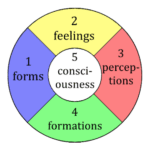the quick path to enlightenment

The 3 roots in Tibetan Buddhism are the Guru, root of blessings, Yidam / deity, root of siddhi or accomplishment, and Dharmapala / protector, the root of Buddha activity. An indispensable means of practicing Tantra, the 3 roots are a Vajrayana manifestation of the 3 jewels.
Table of Contents
3 Jewels Meaning: 3 refuges
The 3 jewels (explained here) are Buddha, Dharma, and Sangha. These are the outer objects of refuge that bring the practitioner onto the path of Hinayana dharma and guide them into the Mahayana dharma. They are reflected in their inner aspect as the Vajrayana symbols of the 3 roots: Guru, Yidam, and Protector.
How to meditate like a yogi
and enter profound samadhi
Guru / Lama – the root of Blessings
The first root is the Lama, the indispensable essence of the Vajrayana. There are 4 gurus: human, visualized, phenomena, and mind. Blessings, also called adhisthana, can be seen as the direct gift of wisdom. Blessings come in multiple forms:
- Abhishekha – ritual empowerment for a tantric mandala. Can be a simple blessing abhisheka or permission to practice a typical ritual.
- Teachings
- Wisdom
- Pith instruction
- Secret teachings
- Practice liturgies
- Lungs (verbal readings)
- Visualized elements, such as light rays, and forms of light
- Symbolic understanding
- Pointing out the nature of mind – this is the essential task of the guru, whatever the manifestation
In Abhishekha, or empowerment, the lama introduces the student to the yidam or deity they will practice in meditation. Through teachings, the guru introduces the student to the view and clarifies the view so they can understand the meaning and intent of the dharma. The guru also gives pith instructions, brief instructions, often to specific students, they should follow for their own benefit.
- Sudden insight
- Strong devotion
- Comprehension of difficult concepts
- Ability to practice
- Transforming obstacles into meditation
- Seeing the essential reality of mind
- Direct perception of emptiness
Physical Guru
The human guru should be regarded as the Buddha in person, only better because he/she is there and the Buddha is no longer with us. In tantra, we should regard all beings as the Buddha, as enlightened beings, so seeing them this way should be easy. To enter the Vajrayana, the student receives the samaya vow, essentially a deep commitment to maintaining an enlightened outlook. It’s essential to always venerate the guru and never to disparage them.
The guru examines the student, giving the appropriate instructions and practices. When they are ready – purified and ripened – he will offer the pointing out instruction. This reveals the nature of mind directly to students. Afterward, this forms the core approach to all Vajrayana practices. It is the ultimate instruction and all other practices form a support to deepen and stabilize direct perception of this instruction. It must be received in person.
Abhishekha is given in person. Here, the student receives their yidam – their deity – which will guide them to accomplishment through practice. Accomplishment means directly seeing the empty, luminous nature of the world as a manifest reality as the 3 kayas – Dharmakaya, Sambhogakaya, and Nirmanakaya.
Lineage
Blessings from the physical guru flow down the lineage. Lineage must be in person, from ‘father to son’ as it were. Each lineage holder, the guru or lama, passes on the authority to practice to qualified students. Moreover, he passes on the authority to teach specific texts, ritual practices, and the pointing out instruction to a select few (or only one) student, who then are the lineage holders. These holders can then carry on the lineage. The blessings have thus been transmitted in an unbroken line.
The history of the guru principle began likely with Padmasambhava, the second Buddha. He brought dharma to Tibet in the first round during the 9th century, establishing the Nyingma lineage. Other lineages followed with the New translation schools
Visualized Guru
The primary practice here is called Guru Yoga. However, all of the ngöndros focus on devotion to the guru in visualized form. The guru in these practices is typically seen as external. The point is to purify obscurations and obstacles so that stronger devotion arises. This generates merit, or the force to continue on the path.
The visualized guru exists as a Sambhogakaya figure – a body of light. Their role is to provide blessings in meditation. This is the common approach in Guru Yoga, where the student unites (yoga) their mind with the guru’s mind. Typically, the practitioner will take refuge and bodhicitta, then visualize the guru in front or on top of the head out of emptiness. The visualized guru emits light-formed blessings in whatever method and form indicated in the text. These dissolve into the student’s body, especially the 3 centers of forehead, throat, and heart.
These blessings allow the student to open their mind to wisdom, to understand the practices on both a conceptual and non-conceptual (direct experience) level, and to accomplish the meditative attainment of that practice. They also prepare them for any subsequent practices. Blessings help to clarify confusion, overcome doubt, generate compassion, turn obstacles into practice, and generally infuse one’s life and practice with genuine dharma and focus.

Flow, the profound mental state, also called Peak Performance, can be attained with meditation, and can be ‘triggered’ at will, with enough discipline. Guide to Flow Mastery will teach you how.
Guru of Phenomena
The guru of phenomena means all the phenomena one encounters ARE the guru. When a negative thing happens in life, this is the guru teaching on aggression, reminding us to purify it or see it, see the emptiness of it, or transform it into the deity. The phenomenal guru constantly acts to help us release attachments to particular outcomes, focusing instead on the sacredness imbuing all phenomena.
All phenomena can awaken you to reality if seen in its pure, sacred nature without fixation. If concept is cut through and yogic direct perception is accomplished. When the yogi becomes a Siddha, accomplishing the meditative powers, written or instructional teachings become less useful and the phenomenal world becomes the guru. Phenomena themselves instruct the advanced practitioner how to behave and how to proceed along their path.
In this system, all sentient beings are the guru. When they insult you, harm you, praise you, and so forth, they are a reflection of your ego. How does your ego respond to being insulted, robbed, attacked, loved, adored, slandered, and so forth? Does the ego respond in any way? If so, that person as guru principle teaches you that you have work to do on that thing, that ego is interfering with your ability to relate to phenomena directly and to access emptiness directly in life.
Guru of Mind / Awareness
Guru of one’s own mind is the fundamental awareness underlying all consciousness. This is the fourth guru, also the nature of reality, the wisdom mind, emptiness beyond concept, etc. The awareness guru is the goal, in essence. Stabilizing this accomplishes all practices. It is easy to mistake other manifestations of mind for this guru. This is because all manifestations of mind are this guru, but not if we perceive it incorrectly.
Therefore, it is essential to clarify the main point of knowing the nature of mind and realize that the other gurus form the basis of support to know this one thing. This guru is what the physical guru is pointing out, it is what we practice always, and it is the key to liberation.
This is the abiding and unchanging reality that never wavers or changes. It has no allegiance to anything. It simply exists as unbiased essential wisdom. When unrealized it is called Buddha Nature, tatagathagharba. When it is realized, it is called Wisdom Mind or Buddha.
Yidam – Root of Siddhi
The second root is the Yidam Deity, the root of siddhi, or accomplishment. Siddhi is also known as power. Siddhi, in this case, is the ability, no matter what one encounters, to not be drawn into samsara, and to always maintain sacredness.
Siddhi is both relative (powers over the world) and absolute (full enlightenment). Yidams can bestow relative siddhi – wealth, fame, beauty, magical powers, super-vision, speed, flying, and so forth. Most of these siddhis are considered not truly useful and cautioned against as they primarily function as a distraction.
Ultimate siddhi occurs progressively, typically along the 10 bhumis. When the mind no longer has any negative emotions, the mind has a degree of siddhi, a measure of power. When the mind routinely and effortlessly transcends the dualistic barrier, the cognitive obscurations that run deeper than the emotions, then the higher bhumis and ultimately enlightenment arise.
The yidam confers these siddhis through intensive meditation practice: visualization of the yidam’s form, recitation of mantra, and meditation on suchness or reality confer siddhi to the practitioner slowly and steadily. This comes about through karmic obscurations being purified through the practice methods.
One of the primary methods of conferring siddhi is meditating on the yidam as an illusory body of light and meditating on all phenomena as the yidam, the fixity of solid reality subsides. This is an aspect of siddhi. The meditation culminates in the dissolution of the deity, which is a means of conferring the siddhi of suchness, the siddhi of remaining in the absolute nature.
Yidam meditations and practices
The yidam is practiced using a ‘sadhana’ or ritualized text. The text has normal components of taking refuge and bodhicitta, followed by a visualization of the yidam. This can have both self and outer manifestations. The practitioner sees him or herself as the yidam and the outer world as the same or reflected yidam. Offerings and praises appear at some point. This accumulates merit very quickly.
Then the main portion of the practice involves focusing closely on the visualization and doing the mantra for the deity. This binds the yogi to the deity and overcomes ordinary conceptions about external phenomena and their own body, speech, and mind. These appearances are then seen as purity and equality. They appear while being empty.
The path primarily works by bringing these two things – the form of the deity and absolute purity beyond form – closer and closer together.
Coalescence is our only philosophy
Mipham the Great
This is not a fabricated perception of reality -it is the way reality is. It is extremely difficult to see, comprehend, and bring together these two aspects: phenomena are illusory appearances and all things are empty. Phenomena in and of themselves are emptiness. This can be experienced much more readily in meditation than in activity.
Even ordinary people have glimpses of this all the time but they don’t particularly understand it. An orgasm, a sneeze, even the flow state, breaks through ordinary perceptions, revealing a tiny glimpse of what siddha might be like. It only counts as siddhi when it is completely stabilized in the mind; when there is an unwavering view of the coalescence of appearance and emptiness.

Flow, the profound mental state, also called Peak Performance, can be attained with meditation and can be ‘triggered’ at will, with enough discipline. Guide to Flow Mastery will teach you how.
Dharmapala, the root of activity
The dharmapalas or protectors are more specifically seen as external. It is rare to visualize oneself as a protector or to unite with the protector as in guru yoga. They are normally called upon at the close of a practice session or in the evening, sometimes repeatedly in wrathful practice to ward off negative forces and events or, even better, to turn those adverse circumstances into the path.
Protectors are usually invoked as external beings. The practitioner will typically do a series of chants calling upon them to protect the dharma and the lineage. Violent imagery is used, but is metaphorical for the destruction of ego and the kleshas, which are the true obstacles to all dharma practice.
One sense of the protector is to bind one to the path. The yidam binds one to wisdom itself. But the protector reveals strayings and confusions to the practitioner so they will return to the accurate path and gain clarity. Protector is often misunderstood. People think it means to protect a person from harm, but it actually means to protect you from losing the dharma and from harming others.
The protectors can help overcome negative emotions, allowing them to arise as wisdoms. Protectors are often visualized in wrathful forms and asked to perform violent actions. This is easily confused to mean that people doing protector chants want revenge on their enemies by violently stopping people.
It’s meant to institute a few things: a strong response to extreme aggression. If someone is that extreme, it will lead to war and violence. The person instigating is creating highly negative karma for themselves, so it is in their interest to prevent evil outcomes. Also, it creates a strong response to negative emotions, especially anger. When anger or hatred arise, sometimes the best response is a protector response, an uncompromising attitude. Images of violence are used because the nature of violence is so immediate, so direct, so uncompromising.
The other helpful attitude is fearlessness. A protector can protect one’s mind from fear, allowing a yogi to act in needed ways. The protector protects the mind of compassion. With this protection, the yogi never loses their concern for sentient beings, but always acts to help and guide them. No negative occurrence can knock them off this approach. Protectors, as unseen, but real beings, allow the yogi to tap into greater forces beyond his self.
What are the 3 jewels of Buddhism?
The 3 jewels are Buddha, dharma and sangha. They transform into the 3 roots of lama, yidam, and dakini in the Vajrayana.
What are the 3 refuges in Buddhism?
The 3 refuges are the 3 jewels of Buddha, dharma and sangha. They correlate to Guru, Deity, and Protector in Tantric Buddhism.
Summary of 3 roots in Vajrayana Buddhism
Guru, yidam and dakini (dharmapala) are the 3 roots of Vajrayana Buddhism. They form the core approaches to walking a tantric path – accumulating blessings, attaining siddhi, and removing obstacles. A necessary component they are summarized in the 1st root, the guru, who is the essence of the 3 roots. The three roots are a mirror of the 3 jewels in the lower yanas.

May all beings be happy
May all beings be peaceful
May all beings be safe
May all beings awaken to the light of their true nature
May all beings be free








